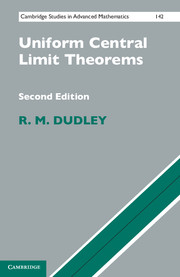Book contents
- Frontmatter
- Dedication
- Contents
- Preface to the Second Edition
- 1 Donsker's Theorem and Inequalities
- 2 Gaussian Processes; Sample Continuity
- 3 Definition of Donsker Classes
- 4 Vapnik–Červonenkis Combinatorics
- 5 Measurability
- 6 Limit Theorems for VC-Type Classes
- 7 Metric Entropy with Bracketing
- 8 Approximation of Functions and Sets
- 9 Two Samples and the Bootstrap
- 10 Uniform and Universal Limit Theorems
- 11 Classes Too Large to Be Donsker
- Appendices
- Bibliography
- Notation Index
- Author Index
- Subject Index
11 - Classes Too Large to Be Donsker
Published online by Cambridge University Press: 05 June 2014
- Frontmatter
- Dedication
- Contents
- Preface to the Second Edition
- 1 Donsker's Theorem and Inequalities
- 2 Gaussian Processes; Sample Continuity
- 3 Definition of Donsker Classes
- 4 Vapnik–Červonenkis Combinatorics
- 5 Measurability
- 6 Limit Theorems for VC-Type Classes
- 7 Metric Entropy with Bracketing
- 8 Approximation of Functions and Sets
- 9 Two Samples and the Bootstrap
- 10 Uniform and Universal Limit Theorems
- 11 Classes Too Large to Be Donsker
- Appendices
- Bibliography
- Notation Index
- Author Index
- Subject Index
Summary
Universal Lower Bounds
This chapter is primarily about asymptotic lower bounds for ∥Pn − P∥F on certain classes F of functions, as treated in Chapter 8, mainly classes of indicators of sets. Section 11.2 will give some upper bounds which indicate the sharpness of some of the lower bounds. Section 11.4 gives some relatively difficult lower bounds on classes such as the convex sets in ℝ3 and lower layers in ℝ2. In preparation for this, Section 11.3 treats Poissonization and random “stopping sets” analogous to stopping times. The present section gives lower bounds in some cases which hold not only with probability converging to 1, but for all possible Pn. Definitions are as in Sections 3.1 and 8.2, with P:= U(Id) = λd = Lebesgue measure on Id. Specifically, recall the classes G(α, K, d):= Gα,K, d of functions on the unit cube Id ⊂ ℝd with derivatives through αth order bounded by K, and the related families C(α, K, d) of sets (subgraphs of functions in G(α, K, d − 1)), both defined early in Section 8.2.
Theorem 11.1 (Bakhvalov) For P = U(Id), any d = 1, 2, … and α > 0, there is a γ = γ (d, α) > 0 such that for all n = 1, 2,…, and all possible values of Pn, we have ∥Pn − P ∥G(α1,d) ≥ γn−α/d.
- Type
- Chapter
- Information
- Uniform Central Limit Theorems , pp. 391 - 416Publisher: Cambridge University PressPrint publication year: 2014



